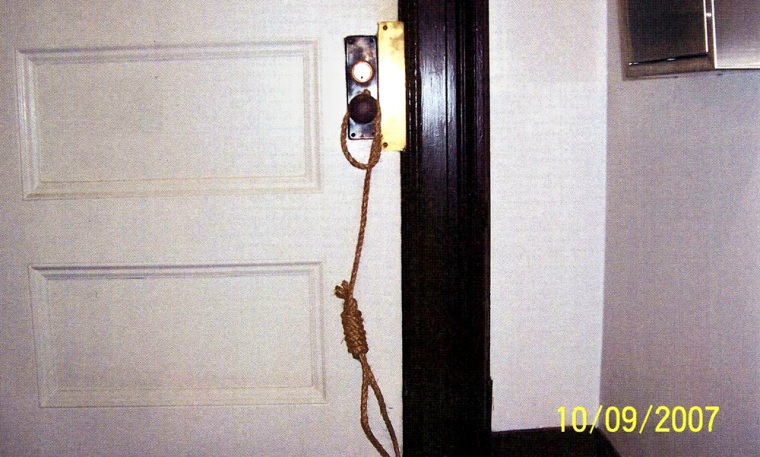In the months since nooses dangling from a schoolyard tree raised racial tensions in Jena, La., the frightening symbol of segregation-era lynchings has been turning up around the country.
Nooses were left in a black Coast Guard cadet’s bag, at a Long Island police station locker room, on a Maryland college campus, and, just this week, on the office door of a black professor at Columbia University in New York.
The noose — like the burning cross — is a generations-old means of instilling racial fear. But some experts suspect the Jena furor reintroduced some bigots to the rope. They say the recent incidents might also reflect white resentment over the protests in Louisiana.
“It certainly looks like it’s been a rash of these incidents, and presumably, most of them are in response to the events in Jena,” said Mark Potok of the Southern Poverty Law Center, which tracks white supremacists and other hate groups. “I would say that as a more general matter, it seems fairly clear that noose incidents have been on the rise for some years.”
Symbol of terror reappears
Thousands of demonstrators, including the Revs. Jesse Jackson and Al Sharpton, converged on Jena on Sept. 20 to decry what they called a racist double standard in the justice system. They protested the way six blacks were arrested on attempted murder charges in the beating of a white student, while three whites were suspended but not prosecuted for hanging nooses in a tree in August 2006.
The noose evokes the lynchings of the Jim Crow South and “is a symbol that can be deployed with no ambiguity. People understand exactly what it means,” said William Jelani Cobb, a professor of black American history at Spelman College in Atlanta.
He said the Jena incident demonstrated to some racists how offensive the sight of a noose can be: “What Jena did was reintroduce that symbol into the discussion.”
Though the terror of the civil rights era is gone, the association between nooses and violence — even death — remains, Potok said.
“The noose is replacing the burning cross in the mind of much of the public as the leading symbol of the Klan,” Potok said.
Potok dismissed the idea that the placing of a noose could be interpreted as a joke, even among people born after the end of segregation.
“I think that it’s true that most of these kids don’t know much about civil rights history,” he said. “But every single one of them understands what a noose means at the end of the day.”
Sightings beyond Jena
As word of the Jena case began circulating, reports of similar incidents arose.
In July, a noose was left in the bag of a black Coast Guard cadet aboard a cutter. A noose was found in August on the office floor of a white officer who had been conducting race-relations training in response to the incident.
In early September, a noose was discovered at the University of Maryland in a tree near a building that houses several black campus groups.
On Sept. 29, a noose appeared in the locker room of the Hempstead, N.Y., police department, which recently touted its efforts to recruit minorities.
On Oct. 2, a noose was seen hanging on a utility pole at the Anniston Army Depot in Alabama.
Last week, the president of historically black Grambling State University in Louisiana announced he would seek sanctions against five teachers who participated in a lesson on race relations that included placing a noose around the neck of a child at a mostly black on-campus elementary school.
The Columbia incident involved a black professor of psychology and education, Madonna Constantine, who teaches a class on racial justice.
The Columbia investigation also follows the arrest on Sunday of a white woman on hate-crime charges alleging she hung a noose over a tree limb and threatened a black family living next door in New York City. The two incidents were “the first noose cases in recent memory” in the city, said Deputy Inspector Michael Osgood, commander of the police Hate Crime Task Force.
Not that the use of nooses for racial intimidation is a new phenomenon.
In 2002, white employees at a Texas industrial company put a noose around a black co-worker’s neck. Charles Hickman sued and was awarded more than $1 million last year.
Potok said the recent noose incidents could represent white backlash over the demonstrations in Jena.
“We’re seeing a lot of generalized white resentment,” he said. “The conversation among many white people, particularly in the South, amounts to the idea that Jena was a black-on-white hate crime that is being widely misconstrued as a case of racial oppression of blacks.”
